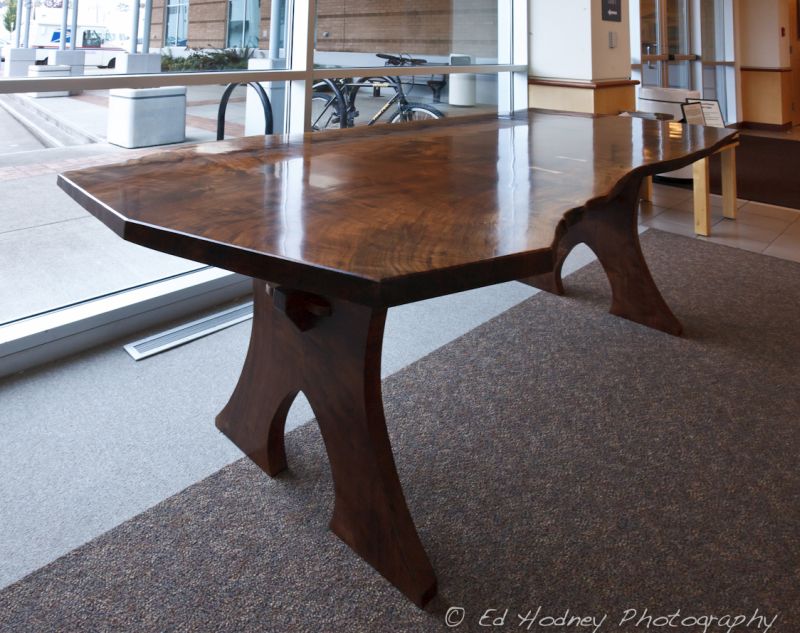Machinery Options for Furniture Parts
A furniture maker with a few standard products to sell gets advice on ways to scale up his production volume. June 4, 2012
Question
While I do have machinery that could stand up to production work, mine is a well-equipped home shop. I have been selling a product to local stores for retail sale, and I have kept up with demand. I would like to expand my market, but need to make the parts more efficiently.
I shape the parts on a router table using templates. I do get some tearout every once in a while, which I would like to eliminate or lessen. I mount a template on the part and trim it to about 1/16th of an inch with a bandsaw, then off to the router with a flush trim bit to bring it to size. I mount the template using screws that are strategically placed so when it's assembled, the holes are used for the assembly of the final product. The product has about 22 parts that are made in this fashion. Is there a way to produce these parts more efficiently? I think a CNC would do the job, but I do not have the business or funding for that.
Forum Responses
(Furniture Making Forum)
From contributor J:
Hard to say without seeing the parts you're trying to make. For instance if you have tight inside curves, you may be limited to a 1/2" shank bit. Whereas if it were something more like a circle, you could set up a spiral insert head with a bearing on a shaper. The advantage of the shaper is it will run all day long and the cutters will last longer, as well as being easier to change.
Of course you could also go with a pin router which would allow you to use the 1/2" bits. Either of these 2 options are very affordable in comparison to a CNC. Of course you could also find a local shop with a CNC to cut parts for you.
From contributor D:
Shop it around your area. Bound to be a few CNC machines sitting idle these days. Parts like that Adirondack chair could also be nested on sheets for more efficient yield of your stock. It's fast and accurate, much quicker than by hand, and you could then just use your time assembling and finishing your product. If demand gets big enough, one day you could justify getting your own machine.
From contributor K:
I would try to cut stacks on the bandsaw, then maybe use a vacuum to hold the template for quick pickup and dropping of the parts for routing. Use the largest diameter bits possible, if you are using small now. Otherwise, I concur with the others to job it out to someone with a CNC.
From the original questioner:
Thanks for the responses! I see if anyone has a CNC they are willing to job out. I suppose I would be looking at a setup fee? Do they normally charge per piece or per hour? Any idea how much if it's per hour?
From contributor D:
Multiple parts on the bandsaw for sure. But park the router and use a real big boy (6 hp or more) shaper with a vacuum jig to hold the part. Always think multiple parts - avoid one at a time operations. With judicious roughing out, you may be able to eliminate the bandsaw and just use a good hogging bit on the shaper to shape. Working with the grain may require two or more passes, but will still be far faster than any router bit.
From contributor S:
If CNC doesn't work out, you can greatly reduce tear-out based on your feed direction.
From the original questioner:
Thanks for all the suggestions. I did find a guy who has a CNC in the area. He said he can run parts at $100/hr. I'd need CAD drawings, which I don't have. Based on my templates, he can do the CAD drawings for $50/hr. Do these costs seem fair? I've used Sketchup in the past. Never used any CAD programs. Are they anything alike?
From contributor L:
If you get the pro version of Sketchup, you can export DFX files, which are often the basis for CAD. It costs $500, and you need to use many facets, instead of the default 24, to make a circle. If the CAD shop uses Sketchup or can import the files into his program, you could save him a good bit of time.
That said, the prices are reasonable, though it really depends on how fast both he and his machine is. He should be able to give a general idea of how fast he is when he sees your sketch. Many programs will read out the time necessary for a given tool path at a given speed, once the CAD stuff is imported. CAD is part art and part science. A good CAD operator will figure feed directions for minimizing chipout, for instance, and have a good sense of feed speeds.
